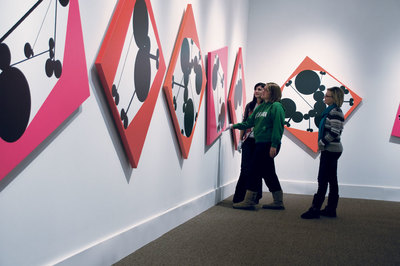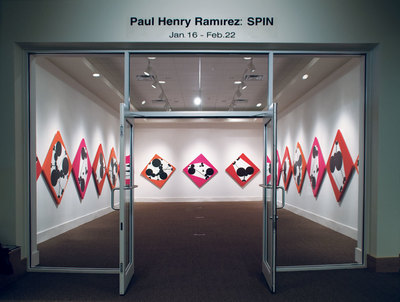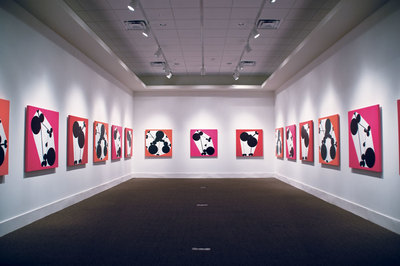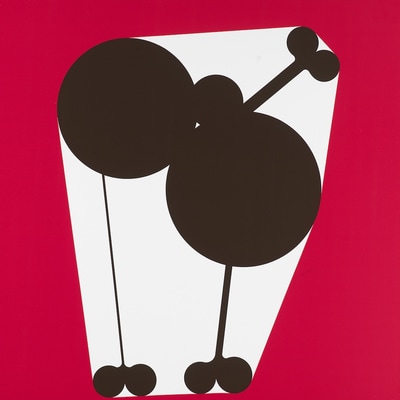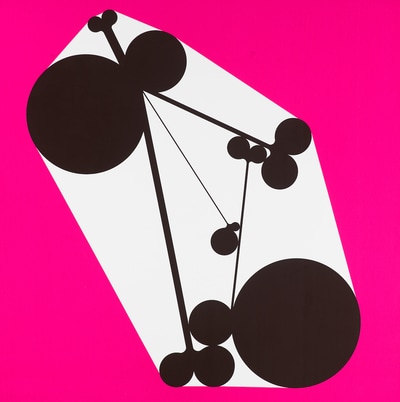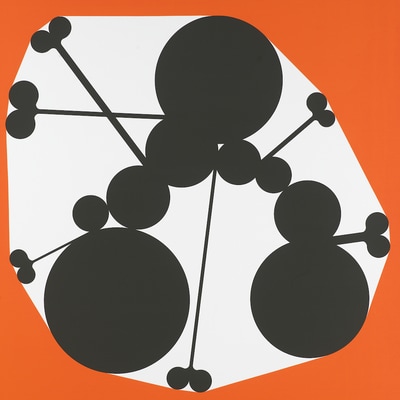SPIN 2009
SPIN 2009
SPIN, Tarble Arts Center, Eastern Illinois University, Charleston, IL
Catalog essay: Modernism with a Wink and a Poke by Saul Ostrow
With the Spin Paintings, which consists of seven sets of three silk-screened images each that have been mounted on turntables, Paul Henry Ramirez extends his practice of recuperating abstract painting as a vehicle to address social and aesthetic issues. Adding modularity, and reproducibility, as well as by referencing the kinetic art of the 50s and 60s, he now uses his practice of creating sexually implicit abstract imagery to explore the implications of repetition, variation, indeterminacy, and choice. By making it possible for the audience to rotate the painting the viewer is given the opportunity to find the internal logics, tensions, and interactions that order the multiple parts of each configuration that Ramirez constructs. This in turn permits them to experience the compositional relationships that would have been negated if Ramirez had made this determination. Secreted in the this inclusion of the audience in the decision-making process, the installation of Spin reaffirms Duchamp’s dictum that the viewer is the artist’s collaborator in that their interaction and interpretation completes the artist’s work.
Despite the seriousness of his undertaking, Ramirez approaches his objectives with a sense of humor, for he is not only aware that abstract art can be covert, but that it also has a repressed libido awaiting to be aroused. He uses this knowledge to imbue the flat colors, uninflected surfaces, and platonic geometric relationships that reflect the idealism once thought to be the quintessential expression of Modernism’s search for the spiritual and the essential with titillating sexual innuendos and allusions. The results occupy the gap between the rarified realm of formalist principles and historical references, and the commonplace world of popular culture and social relations.
Ramirez develops his imagery by repurposing historical models. The bold and emblematic geometric compositions of the Spin Painting and the CHUNK paintings (2007) employ deStijl and Russian Constructivism principles. The difference lies in the fact that Ramirez’s configures his circles and bars to form suggestive images transforming the geometric and biomorphic vocabularies of formalism into texts that signify whimsical narratives of inter-dependence and inter-action. Unlike the fantasies conjured up by his earlier works, which used as their source material the sexuality encrypted in the biomorphic forms of Joan Miro, and the early works of Mark Rothko, and Arshile Gorky, the Spin paintings are less jocular and more sophisticated in their style and composition.
Though Ramirez’s imagery may make us chuckle, snicker, or blush, his intent is not to parody the seriousness or ambitiousness of high modernisms’ attempt to reveal the truth that lies behind appearances. Instead, the dirty jokes that result from Ramirez’s simple modifications of the syntax and form of geometric abstraction, actually turn the formalist language of abstraction back onto itself, inverting the un-representable otherness that it originally was meant to express into something worldly. With in this strategy, we find echoes of Duchamp inscribing onto a reproduction of the Mona Lisa the letters L.H.O.O.Q, which when pronounced in French is the colloquialism “she is hot in the ass (or has a hot ass).
Subsequently, the resulting assemblage of historical references, and the implicit political, and social texts concerning sexuality not only are meant to undermine or transgress the transcendental ideals of the modernist models, but also reposition formalism and abstraction by making visible their ability to comment on and to be relevant to contemporary life. As if this were not enough – the addition of the audience’s participation makes explicit that abstract paintings are not merely a pictorial encoding of formal or idealistic values, but are complex things that if armed with a wink and a poke can again position their viewer as active participants in the real world.
SPIN, Tarble Arts Center, Eastern Illinois University, Charleston, IL
Catalog essay: Modernism with a Wink and a Poke by Saul Ostrow
With the Spin Paintings, which consists of seven sets of three silk-screened images each that have been mounted on turntables, Paul Henry Ramirez extends his practice of recuperating abstract painting as a vehicle to address social and aesthetic issues. Adding modularity, and reproducibility, as well as by referencing the kinetic art of the 50s and 60s, he now uses his practice of creating sexually implicit abstract imagery to explore the implications of repetition, variation, indeterminacy, and choice. By making it possible for the audience to rotate the painting the viewer is given the opportunity to find the internal logics, tensions, and interactions that order the multiple parts of each configuration that Ramirez constructs. This in turn permits them to experience the compositional relationships that would have been negated if Ramirez had made this determination. Secreted in the this inclusion of the audience in the decision-making process, the installation of Spin reaffirms Duchamp’s dictum that the viewer is the artist’s collaborator in that their interaction and interpretation completes the artist’s work.
Despite the seriousness of his undertaking, Ramirez approaches his objectives with a sense of humor, for he is not only aware that abstract art can be covert, but that it also has a repressed libido awaiting to be aroused. He uses this knowledge to imbue the flat colors, uninflected surfaces, and platonic geometric relationships that reflect the idealism once thought to be the quintessential expression of Modernism’s search for the spiritual and the essential with titillating sexual innuendos and allusions. The results occupy the gap between the rarified realm of formalist principles and historical references, and the commonplace world of popular culture and social relations.
Ramirez develops his imagery by repurposing historical models. The bold and emblematic geometric compositions of the Spin Painting and the CHUNK paintings (2007) employ deStijl and Russian Constructivism principles. The difference lies in the fact that Ramirez’s configures his circles and bars to form suggestive images transforming the geometric and biomorphic vocabularies of formalism into texts that signify whimsical narratives of inter-dependence and inter-action. Unlike the fantasies conjured up by his earlier works, which used as their source material the sexuality encrypted in the biomorphic forms of Joan Miro, and the early works of Mark Rothko, and Arshile Gorky, the Spin paintings are less jocular and more sophisticated in their style and composition.
Though Ramirez’s imagery may make us chuckle, snicker, or blush, his intent is not to parody the seriousness or ambitiousness of high modernisms’ attempt to reveal the truth that lies behind appearances. Instead, the dirty jokes that result from Ramirez’s simple modifications of the syntax and form of geometric abstraction, actually turn the formalist language of abstraction back onto itself, inverting the un-representable otherness that it originally was meant to express into something worldly. With in this strategy, we find echoes of Duchamp inscribing onto a reproduction of the Mona Lisa the letters L.H.O.O.Q, which when pronounced in French is the colloquialism “she is hot in the ass (or has a hot ass).
Subsequently, the resulting assemblage of historical references, and the implicit political, and social texts concerning sexuality not only are meant to undermine or transgress the transcendental ideals of the modernist models, but also reposition formalism and abstraction by making visible their ability to comment on and to be relevant to contemporary life. As if this were not enough – the addition of the audience’s participation makes explicit that abstract paintings are not merely a pictorial encoding of formal or idealistic values, but are complex things that if armed with a wink and a poke can again position their viewer as active participants in the real world.
